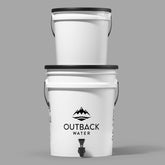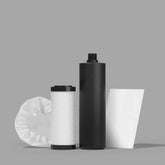Pressure versus gravity.
There are a wide variety of water filtration systems designed to remove a varied range of contaminants from simple debris to pathogenic, waterborne microorganisms. To meet these challenges there are a multitude of water purifying “mediums” used to get the appropriate job done.
Generally, water filters are designed to treat water under 20-200 pounds per square inch of pressure (psi). These filter systems are found in homes, offices, manufacturing facilities, et cetera and are used to treat municipal or other water supplies where pressure can be applied to accomplish the filtration process.
When a pressurized water supply isn’t available, the water filtration process relies on “hydrostatic head pressure,” or simply put, gravity. The question becomes, “Is it possible to effectively remove unwanted contaminants from water without pressure?” And the answer is a resounding, “Yes.”
What is it and how does it work?
To understand our gravity powered water filter system you have to understand the differences between “standard filters” (those designed for pressure-driven applications) and “gravity filters” (those designed for non-pressurized applications). So let’s take a closer look.
First, let’s look at water filters that use hydrophobic material. This type of media naturally repels water so it beads on the surface and doesn’t pass through easily. These filters restrict water flow. And although appropriate in pressurized systems, they are not suitable for use in no-pressure, low-pressure or gravity powered water filtering systems.
Second, materials with an affinity for water are known as having hydrophilic characteristics. These kinds of media allow water to spread across the surface, create maximum contact with the material, absorb water easily and allow water to pass through with less effort. These types of water filters create minimal flow resistance and are ideal for use in low-pressure, no-pressure or gravity powered systems.
The next critical factor is the media's ability to remove the desired contaminant. This is often based on the size of the pores, or openings, in the material. For instance, if a flat sheet material is to be used in a gravity powered water filter, a hydrophilic, flexible, non-metallic media is recommended. Most often composed of cloth or non-woven fibers such as glass or cotton, these fibrous materials are woven into a web-like configuration with uniform pore sizes (micron rating) to achieve the removal of specific, size-related contaminants, such as sediment, bacteria and cysts. In some cases, these gravity water filters are capable of ultra-filtration, which is defined as filtration using a medium fine enough to retain colloidal particles, viruses or large molecules. In some cases materials such as carbon can be adhered to the fibrous material to help in the removal of even more contaminants. The flat sheet material is most often pleated to maximize the water filter’s surface area and help minimize back pressure.
At this point, we have selected an appropriately hydrophilic flat sheet filtration media, which has removal capabilities suitable for the application. We now pleat that material, creating a pleat-pack from the flat sheet material. This maximizes the number of pleats, increases the filtration surface area and creates optimal water filter efficiency.
The final two critical factors are structure and fit. To ensure structural soundness of the water purifying filter, a solid “skeleton” or “frame” is designed to support and protect the pleated filter media. A solid center core is the “spine” and an outer shroud (think of it as a rib cage) protects the heart of the water filter, the media pleat-pack. All are solidly connected to durable end caps to complete the body of the filter.
And finally, the filter is “fitted” to the emergency survival system in a secure, leak-proof and by-pass proof manner by using either a threaded connection or a double o-ring seal. Loose-packed filters (canisters) or filters incorporating hollow fiber membrane material can also be used in gravity powered water filter applications. In this case canisters are loosely filled with the media (compaction will hinder the flow in a gravity environment) and either wire mesh, screens, or highly porous pads are placed inside both ends of the canister to contain the media and avoid migration into the water. These screens have openings small enough to contain the loaded media yet large enough to minimize any flow restriction. They are held in place by installing end caps on both ends of the canister. Loose-pack filters can contain a variety of media based on the contaminant removal required. Commonly used media with excellent general removal capabilities are granular activated carbon or anion resin. But the gravity water filter might also contain material designed to remove specific contaminants such as arsenic, for example. As with the pleat-pack filter, the integrity of the design and fit are still of paramount importance.
Advantages of gravity powered Technology
There are several advantages to using a gravity powered water purifier system. It can be used virtually anywhere, is extremely portable, requires no installation, and with proper water filter selection, its effectiveness in removing undesirable elements is unmatched. The key to an advanced emergency water filtration system is the amount of time the water is allowed to remain in contact with the filter media, otherwise known as “contact time.” The slower the flow rate, the greater the “contact time” which generates more opportunities for the water filter to do its job. This results in high levels of contaminant removal. See test results for Outback Water Systems here.
NOTES: *Filter Medium or Media: is a natural, synthetic or manufactured material used for water filtration. Filter media have a porous structure that is permeable to liquids and gasses. Emergency water filter media should have the following properties:
- An appropriate porosity (with pores of such size that the particles of the filter cake are trapped in the filter medium).
- Chemical resistance to the filtrate.
- Sufficient mechanical strength.
- Thermal resistance at the temperature at which the water filtration is carried out. Filter media may be either flexible or inflexible. Flexible filter media include metallic barriers in the form of perforated sheets or screens made of steel, copper, aluminum, nickel, silver or other materials. Such media are especially suitable for the filtration of chemically aggressive fluids and for filtration at elevated temperatures or with large mechanical stresses. Flexible media also may be nonmetallic barriers consisting of cloth or nonwoven fibers. Such nonmetallic media may be made of asbestos, glass, cotton, wool, polyvinyl chloride or poly fiber. Inflexible media include rigid disks, slabs, canisters and sheets made by molding sintering powdered ceramics, metals, glass or synthetic materials. Such media also may consist of beds of unconsolidated particles of stone, coal, charcoal, coke, diatomaceous earth, sand or clay.
There is often a distinction between thin and thick (en masse) water filter media, too. In thin media, such as filter paper or filter cloth, the pores are smaller than the particles to be removed from the fluid. The pores of thick media, such as a charcoal bed or wood pulp, may be appreciably larger than the particles to be removed.
- Choosing a selection results in a full page refresh.








